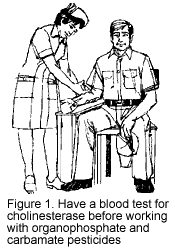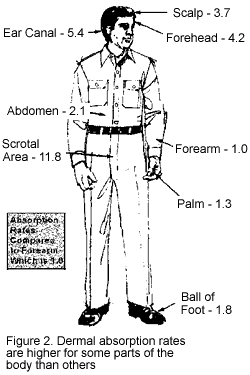Farmers and anyone working with organophosphate and carbamate pesticides should get a baseline cholinesterase blood test now so their physician can determine if a summertime illness is the result of exposure to these pesticides.
It is important that the test be taken before handling organophosphate and carbamate pesticides to ensure that cholinesterase levels will not be affected by a recent exposure to these chemicals.
WHAT IS CHOLINESTERASE?
 Cholinesterase is an enzyme that is needed for the proper function
of the human body:s nervous system. Like humans, vertebrates
and insects (pests that are controlled with organophosphates
and carbamates) also have this same type of enzyme. Pesticides
in the organophosphate and carbamate chemical class contain
a cholinesterase inhibitor, which makes them effective in controlling
insects and other vertebrates (pests). Unfortunately, when people
breathe in these pesticides or it gets on their skin, they are
subjected to the same negative effect.
Cholinesterase is an enzyme that is needed for the proper function
of the human body:s nervous system. Like humans, vertebrates
and insects (pests that are controlled with organophosphates
and carbamates) also have this same type of enzyme. Pesticides
in the organophosphate and carbamate chemical class contain
a cholinesterase inhibitor, which makes them effective in controlling
insects and other vertebrates (pests). Unfortunately, when people
breathe in these pesticides or it gets on their skin, they are
subjected to the same negative effect.
WHAT IS THE FUNCTION OF CHOLINESTERASE IN THE BODY?
The health effects of this jamming from cholinesterase inhibition can include headaches, dizziness, nausea, restlessness, anxiety, mental confusion, shortness of breath, diarrhea, convulsions, coma, and death.
WHY SHOULD YOU HAVE A CHOLINESTERASE TEST NOW?
 During this absence from pesticides, the body:s cholinesterase
levels have returned to normal, so a physician can determine
a baseline through a blood test. This summer, if you develop
symptoms indicating that you have an illness that could be
the result of exposure to an organophosphate or carbamate
pesticide, your physician can compare your current cholinesterase
levels with baseline levels taken before the spraying season
began. This comparison provides the physician with information
that can confirm or refute pesticide exposure as the cause
of the illness.
During this absence from pesticides, the body:s cholinesterase
levels have returned to normal, so a physician can determine
a baseline through a blood test. This summer, if you develop
symptoms indicating that you have an illness that could be
the result of exposure to an organophosphate or carbamate
pesticide, your physician can compare your current cholinesterase
levels with baseline levels taken before the spraying season
began. This comparison provides the physician with information
that can confirm or refute pesticide exposure as the cause
of the illness.
According to Kenneth Rosenman, MD, a Board Certified Internal and Occupational/Environmental Medicine specialist for Michigan State University, a baseline reading before and periodic testing of cholinesterase throughout the spray season is also useful to determine if work practices and protective equipment are adequate.
Rosenman points out that a 20 percent decrease of cholinesterase from baseline levels is an indication that a farmer needs to review his or her work practices to minimize any potential health effects. Symptoms typically don:t occur until more than a 50 percent decrease from baseline, with severe poisoning occurring at a 90 percent decrease. At a 50 percent decrease from the baseline the applicator should be removed from jobs involving these pesticides until cholinesterase levels recover.
This document is part of the Safety News Series, Agricultural Engineering Department, Michigan State University Extension, East Lansing, Michigan, 48824-1323. Publication date: March 1994.
Howard J. Doss, Safety Leader, Agricultural Engineering Department, Michigan State University, East Lansing, MI 48824-1323. Reviewed by the MSU Extension Pesticide Education Coordinator. This information is for educational purposes only. Reference to commercial products or trade names does not imply endorsement by the MSU Extension or bias against those not mentioned.
Disclaimer and Reproduction Information: Information in NASD does not represent NIOSH policy. Information included in NASD appears by permission of the author and/or copyright holder. More